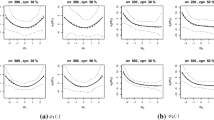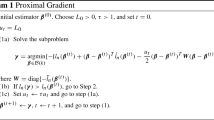Abstract
Nowadays, a series of methods are based on a L 1 penalty to solve the variable selection problem for a Cox’s proportional hazards model. In 2010, Xu et al. have proposed a L 1/2 regularization and proved that the L 1/2 penalty is sparser than the L 1 penalty in linear regression models. In this paper, we propose a novel shooting method for the L 1/2 regularization and apply it on the Cox model for variable selection. The experimental results based on comprehensive simulation studies, real Primary Biliary Cirrhosis and diffuse large B cell lymphoma datasets show that the L 1/2 regularization shooting method performs competitively.


Similar content being viewed by others
References
Akaike H (1973) Information theory and an extension of the maximum likelihood principle. In: Petrov BN, Caki F (eds) Second International Symposium on Information Theory. Akademiai Kiado, Budapest, pp 267–281
Brier GW (1950) Verification of forecasts expressed in terms of probability. Mon Weather Rev 78:1–3
Candes E, Tao T (2007) The Dantzig selector: statistical estimation when p is much larger than n. Ann Stat 35:2313–2351
Chen S, Donoho DL, Saunders M (2001) Atomic decomposition by basis pursuit. SIAM Rev 43:129–159
Cox DR (1972) Regression models and life-tables. J R Statist Soc B 34:187–220
Cox DR (1975) Partial likelihood. Biometrika 62:269–276
Dickson E, Grambsch P, Fleming T, Fisher L, Langworthy A (1989) Prognosis in primary biliary cirrhosis: model for decision making. Hepatology 10:1–7
Donoho DL, Elad E (2003) Maximal sparsity representation via l1 minimization. Proc Natl Acal Sci 100:2197–2202
Donoho DL, Huo X (2001) Uncertainty principles and ideal atomic decomposition. IEEE Trans Inf Theory 47:2845–2862
Fan J, Heng P (2004) Nonconcave penalty likelihood with a diverging number of parameters. Ann Stat 32(2):928–961
Fan J, LI R (2001) Variable selection via nonconcave penalized likelihood and its oracle properties. J Am Stat Assoc 96:1348–1360
Fan J, LI R (2002) Variable selection for Cox’s proportional hazards model and frailty model. Ann Stat 30:74–99
Faraggi D, Simon R (1998) Bayesian variable selection method for censored survival data. Biometrics 54:1475–1485
Fu W (1998) Penalized regression: the bridge versus the lasso. J Comp Graph Stat 7:397–416
Graf E, Schmoor C, Sauerbrei W, Schumacher M (1999) Assessment and comparison of prognostic classification schemes for survival data. Stat Med 18:2529–2545
Gui J, Li H (2005) Penalized Cox regression analysis in the high-dimensional and low-sample size settings, with applications to microarray gene expression data. Bioinformatics 21:3001–3008
Heagerty PJ et al (2000) Time dependent ROC curves for censored survival data and a diagnostic marker. Biometrics 56:337–344
Huang J, Harrington D (2002) Penalized partial likelihood regression for right censored data with bootstrap selection of the penalty parameter. Biometrics 58:781–791
Ibrahim JG, Chen M-H, Maceachern SN (1999) Bayesian variable selection for proportional hazards models. Can J Stat 27:701–717
Qian J, Li B, Chen PY (2010) Generating survival data in the simulation studies of cox model. Inf Comput (ICIC) 4:93–96
Rosenwald A et al (2002) The use of molecular profiling to predict survival after chemotherapy for diffuse large B-cell lymphoma. New Engl J Med 346:1937–1946
Sauerbrei W, Schumacher M (1992) A bootstrap resampling procedure for model building: application to the cox regression model. Stat Med 11:2093–2109
Schwarz G (1978) Estimating the dimension of a model. Ann Stat 6:461–464
Smyth P (2001) Model selection of probabilistic clustering using cross-validated likelihood. Stat and Comput 10:63–72
Therneau TM, Grambsch PM (2000) Modeling survival data: Extending the Cox model. Springer-Verlag Inc., NewYork
Tibshirani R (1996) Regression shrinkage and selection via the lasso. J R Stat Soc B 58:267–288
Tibshirani R (1997) The lasso method for variable selection in the Cox model. Stat Med 16:385–395
Van Der Laan MJ, Dudoit S, Keles S (2003) Asymptotic Optimality of likelihood based Cross Validation, Technical Report, Division of Biostatistics, University of California, Berkeley
Verwij PJM, Van Houwelingen JC (1993) Cross validation in survival analysis. Stat Med 12:2305–2314
Xu ZB, Zhang H, Wang Y, Chang XY (2010) L 1/2 regularization. Sci China, ser F 40(3):1–11
Zhang HH, Lu W (2007) Adaptive Lasso for Cox’s proportional hazards model. Biometrika 94:691–703
Zhao P, Yu B (2007) Stagewise Lasso. J Mach Learn Res 8:2701–2726
Zou H (2006) The adaptive Lasso and its oracle properties. J Am Stat Assoc 101(476):1418–1429
Zou H, Hastie T (2005) Regularization and variable selection via the elastic net. J R Stat Soc B 67:301–320
Acknowledgments
This work was supported by the Macau Science and Technology Develop Funds (Grant No. 017/2010/A2) of Macau SAR of China and the National Natural Science Foundation of China (Grant No. 11171272).
Author information
Authors and Affiliations
Corresponding author
Additional information
Communicated by G. Acampora.
Rights and permissions
About this article
Cite this article
Luan, XZ., Liang, Y., Liu, C. et al. A novel L1/2 regularization shooting method for Cox’s proportional hazards model. Soft Comput 18, 143–152 (2014). https://doi.org/10.1007/s00500-013-1042-6
Published:
Issue Date:
DOI: https://doi.org/10.1007/s00500-013-1042-6




